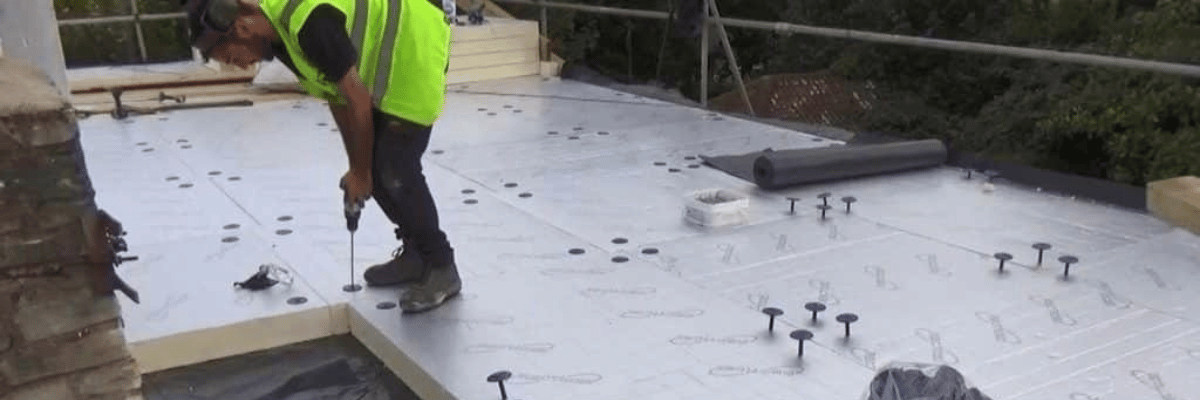Are you having problems with your flat roof? Has it failed despite only recently costing you a fortune? Perhaps you’re looking to upgrade or retrofit your domestic or commercial premises with a flat roof, but you’re hesitant about the type of flat roof you need. What is a warm roof? Could it be the answer?
With so many flat roof types, variations and materials available, it can be difficult to know if you’re making the right choice. How do you choose the right roof for your building unless you know what makes a ‘good’ one?
After all, the wrong choice or a quick and seemingly inexpensive option can lead to disaster. A roof that fails is stressful, expensive and causes monumental damage to your home or business.
So what is a warm roof? How does it work, and why does it matter? All the essential info you need is right here…
What Is A Warm Roof?
So what is a warm roof, you ask? A warm roof is a type of flat roof designed to last longer, insulate better and reduce the risk of damage due to condensation.
First things first, let’s cover the basics of what a flat roof is in order to answer the question, ‘What is a warm roof?’
A warm roof is made up of a few essential components: joists, a structural deck, a vapour control layer (VCL), insulation and a waterproof covering.
The main difference between a cold roof and a warm roof is that the insulation layer goes above the structural deck rather than in between the joists, moving the dew point up, and reducing the risk of condensation forming. (No idea what a dew point is? Don’t worry, we’ll explain that later…)
The result? Condensation cannot form on the underside of the structural deck, nor are cold draughts brought down into the building from the outside. Giving you a warm, well-insulated property free from condensation and all the problems it brings.
How Does A Warm Roof Work?

As the name suggests, a warm roof design creates a climate of warmth within the roof structure. With a warm roof, the roof void remains insulation-free with the structural deck fixed in place above the joists and a VCL adhered to the top side. The PIR insulation boards are then fixed above the structural deck and topped with a sealed waterproofing layer.
Vents between your property’s living area and roof area are sealed to prevent warm and cold air mixing. The warm air from the inside of the property rises and remains within the roof space, while the cold air is kept out of the roof, thanks to the PIR insulation boards of a warm roof design.
The ‘Dew Point’, the point at which cold and warm air streams meet, mix and form moisture, is higher in a warm roof compared to other roof structures. In fact, in a warm roof, the Dew Point happens within the PIR insulation and moisture-tolerant boards, away from the roof timber, so there are no moisture spots in the roof space causing condensation issues.
Essentially, the PIR insulation boards of the warm roof structure act as a barrier and protective insulating layer that keeps cold air out and warm air in.
The Benefits Of A Warm Roof
There are many great benefits to installing a warm roof. Let’s take a look at them:
Protects Your Property
A warm roof stops condensation from forming and helps to prevent blistering or splitting of the outer layer of your roof. It protects the life of your roof and stops costly and difficult-to-fix roof failures. If you want a long-lasting and low-maintenance roof, a warm roof design is the way to go.
Longer-Lasting
Condensation is one of the leading causes of rotting timbers and structural damage that results in the need for a roof replacement. Because a warm roof is less susceptible to condensation and damp than a cold roof, a warm roof may last longer. Saving you money and ensuring that your investment is a good one.
Save On Heating
With a warmer property, there’s less need to heat it. You could save yourself a fortune in heating bills thanks to the economical effect of a warm roof. You’ll find your property is better insulated, so the need to turn up the thermostat will reduce. And let’s not forget, keeping your heating low is also brilliant news for the environment.
Better For Your Health
A warm roof prevents moisture spots within your roof space and condensation on your roof frame. As you’re probably aware, excess condensation leads to mould and damp spots that are detrimental to your health, especially when your body is exposed to the issues over a long period of time. A warm roof not only protects your property, but your health too.
Cheaper & Easier To Install
Warm roofs are often cheaper, easier and faster to install. In most cases, you don’t have to replace the deck as you might with a cold roof. This means you save not only on the cost of replacement wood but also on labour costs and time.
Also, if your existing roofing system is still sound, you might be able to reuse it as the vapour control layer, again saving you money.
No VAT On Many Warm Roofs
In many cases, when you’re installing a warm roof you’re improving the thermal efficiency of the roof. If this is the case, then you should qualify for a special government scheme that means you won’t have to pay any VAT. This can save you thousands of pounds.
How Does A Warm Roof Compare To A Cold Roof?
You may have heard of a cold roof – it’s another way of insulating a flat roof. In order to answer, what is a warm roof, let’s see how the two compare.
Both warm and cold flat roofs were designed with condensation in mind. However, the two different designs approach the issue of condensation differently, and there is one definite winner when it comes to effectiveness.
The cold roof design attempts to reduce condensation by allowing for ventilation. Vents between the insulation and the roof deck are created so air can flow in from the outside, through the roof and blast away any condensation. Both warm and cold air are thus able to mix together. But when warm and cold air streams merge, some condensation forms, mostly in the areas the ventilation cannot reach.
In contrast, the warm roof design does not allow the mixing of warm and cold air. Instead, the differing air temperatures are separated by the PIR insulating layer. Warm air is contained within the property, whilst cold air is kept out. Vents are also closed to prevent cold air from filtering into the property from elsewhere. Warm and cold air are unable to merge and condensation cannot form.

So Which Is More Effective At Preventing Condensation?
The warm roof structure has proved to be the champion in the condensation prevention stakes. While the cold roof design allows ventilation, this is only effective for some areas of the property. The mixing of warm and cold air causes condensation, and while ventilation helps, it cannot prevent all condensation – especially in tucked away or hard-to-reach spots.
Consequently, cold roof structures lead to condensation issues and the resulting problems with mould, spores, and the expensive rotting of timber. Not to mention chilly draughts in cold weather and rising fuel costs to keep your property warm.
On the other hand, warm roofs tackle condensation by preventing warm and cold air from mixing. No condensation occurs thanks to this clever structural design. After decades of trial and error, the warm roof reigns supreme in tackling condensation AND insulation.
The Reigning Roof Champion
Are you contemplating the best type of flat roof for your home or business? Have you wondered what a warm roof is and what difference it makes? Now you have your answer.
Warm roofs are the best at preventing condensation and offer a thermally efficient flat roof solution that can help reduce your spending on heating costs. Their structural design keeps cold air out, warm air in, and moisture at bay. Giving you a warmer property, free from draughts and the risk of toxic mould.
You can save yourself money on heating bills and relax knowing your roof will last. With a warm roof, your investment and property are protected for many years to come. Plus, if ever anyone asks you, ‘What is a warm roof?’ you can reliably answer them!
Would you like to find out more about the best roof solution for your property? Download our roofing guide, completely free for you, here.

